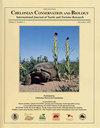Factors Affecting the Long-Term Population Dynamics of Green Turtles (Chelonia mydas) in Ogasawara, Japan: Influence of Natural and Artificial Production of Hatchlings and Harvest Pressure
IF 0.8
4区 生物学
Q3 ZOOLOGY
引用次数: 12
Abstract
Abstract The Ogasawara Islands in Japan represent an important rookery for green sea turtles (Chelonia mydas) in the Pacific Ocean. The marine turtle population in these islands was severely depleted due to overexploitation in the 1800s; however, continuous nesting surveys starting in 1975 showed signs of a gradual recovery, and an upward trend of nesting females has been observed in recent years. The Japanese government undertook a “hatch and release project” to recover the turtle stock in 1910 as the world's first attempt of a sea turtle hatchery. A total of more than 251,000 hatchlings were released into the wild as a part of the project; however, its contribution to the recent increase in nesting females is not well understood. The increase in nesting females may be attributed to the temporary suspension of the turtle harvest and reduction of catch from 1942 to 1968, which allowed for stable production of hatchlings from natural beaches. This study documents the levels of harvest, number of nesting females, and hatchling production at Ogasawara and explores, for the first time, their influence on population dynamics of Ogasawara's green turtles.影响日本小笠原绿海龟(Chelonia mydas)长期种群动态的因素:天然和人工孵化及收获压力的影响
摘要日本小笠原群岛是太平洋绿海龟的重要栖息地。由于19世纪的过度开发,这些岛屿上的海龟数量严重减少;然而,从1975年开始的连续筑巢调查显示出逐渐恢复的迹象,近年来观察到筑巢雌性的数量呈上升趋势。1910年,日本政府实施了一项“孵化和放生项目”,以回收海龟种群,这是世界上第一次尝试建立海龟孵化场。作为该项目的一部分,共有超过25.1万只幼崽被放归野外;然而,它对最近筑巢雌性数量增加的贡献尚不清楚。筑巢雌性海龟的增加可能归因于1942年至1968年海龟捕捞的暂时停止和捕获量的减少,这使得在自然海滩上稳定地生产出幼海龟。这项研究记录了小笠原的收获水平、筑巢雌性数量和孵化产量,并首次探讨了它们对小笠原绿海龟种群动态的影响。
本文章由计算机程序翻译,如有差异,请以英文原文为准。
求助全文
约1分钟内获得全文
求助全文
来源期刊
CiteScore
1.70
自引率
14.30%
发文量
17
审稿时长
>12 weeks
期刊介绍:
Chelonian Conservation and Biology is a biannual peer-reviewed journal of cosmopolitan and broad-based coverage of all aspects of conservation and biology of all chelonians, including freshwater turtles, marine turtles, and tortoises. Manuscripts may cover any aspects of turtle and tortoise research, with a preference for conservation or biology. Manuscripts dealing with conservation biology, systematic relationships, chelonian diversity, geographic distribution, natural history, ecology, reproduction, morphology and natural variation, population status, husbandry, community conservation initiatives, and human exploitation or conservation management issues are of special interest.

 求助内容:
求助内容: 应助结果提醒方式:
应助结果提醒方式:


